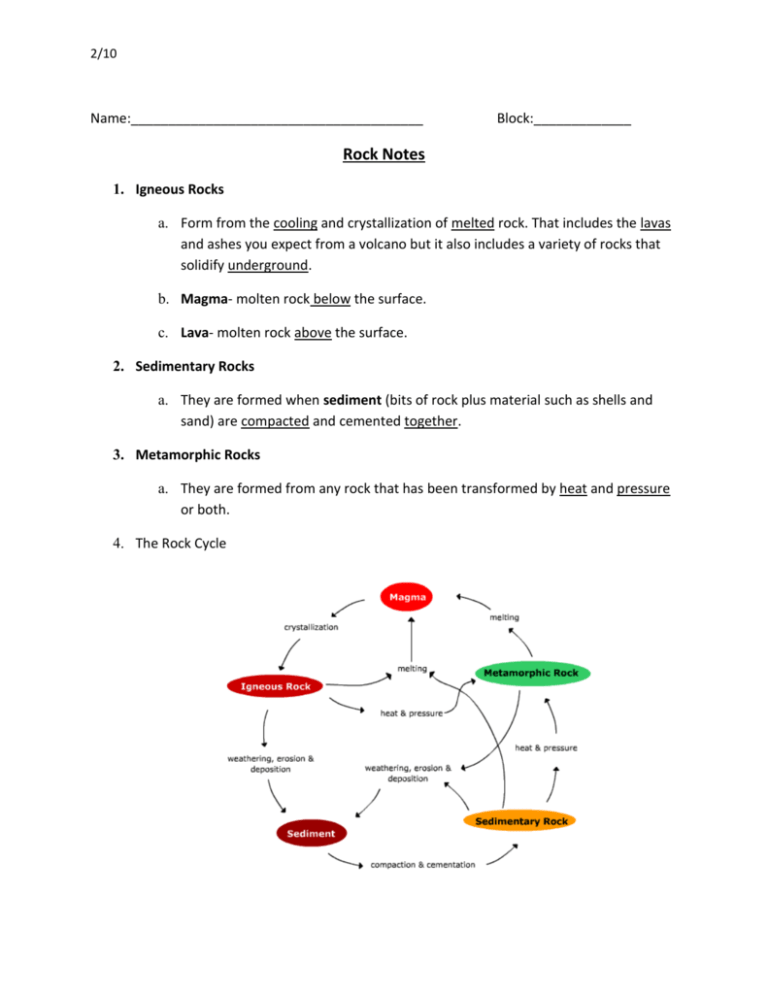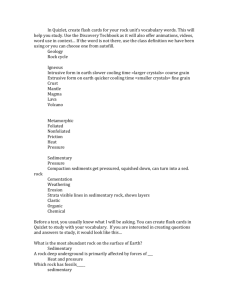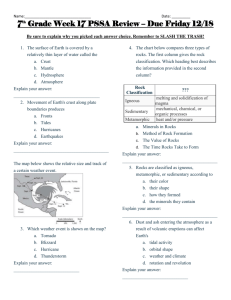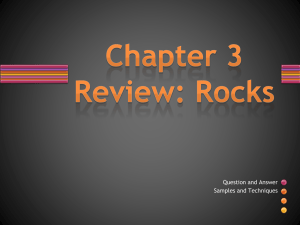Rock Notes
advertisement

2/10 Name:_______________________________________ Block:_____________ Rock Notes 1. Igneous Rocks a. Form from the cooling and crystallization of melted rock. That includes the lavas and ashes you expect from a volcano but it also includes a variety of rocks that solidify underground. b. Magma- molten rock below the surface. c. Lava- molten rock above the surface. 2. Sedimentary Rocks a. They are formed when sediment (bits of rock plus material such as shells and sand) are compacted and cemented together. 3. Metamorphic Rocks a. They are formed from any rock that has been transformed by heat and pressure or both. 4. The Rock Cycle 2/10 5. Identifying the Rock Type a. Igneous rocks are recognized by: i. the interlocking texture of the grains ii. the presence of vesicules (holes) in extrusive igneous rocks iii. may be dark-colored and heavy iv. may display two grain sizes, one much larger than the other b. Sedimentary rocks are recognized by: i. grains cemented together ii. the presence of fossils iii. light-colored and light weight iv. may display interlocking grains but is very light weight c. Metamorphic rocks are recognized by: i. the interlocking texture of large grains ii. foliation (layering) iii. banded light and dark colors iv. "ching" sound instead of a "chunk" sound when tapped 6. Igneous Rock Types a. Felsic Magma- thick, slow moving and contains large amounts of silica b. Mafic Magma- hotter, thinner, and more fluid and contains large amounts of iron and magnesium. c. Extrusive igneous rocks- lava exits Earth's surface and harden rapidly. This does not allow large crystals to form. Can have a fine texture or glassy texture. d. Intrusive igneous rocks- magma cools inside the Earth's surface. Because it cools slowly, large crystals form and cause the rock to have a coarse texture. 2/10 7. Igneous Rock Features a. A pluton is a rock mass that forms when magma cools inside Earth's interior. b. Batholith-Largest of all plutons and often forms the core of many mountatin ranges. Usually made of granite and can be exposed by uplift and erosion. c. Laccolith-formed when magma is stiff and bulges upward to form a domed mass. d. Dike-sheet of igneous rock that cuts across rock layers through cracks. e. Sill-sheet of igneous rock that is forced between rock layers. 8. Igneous Rock Examples: a. Granite, Scoria, Pumice, Basalt, Gabbro, Obsidian 2/10 9. Sedimentary Rock Types a. Clastic sedimentary rocks are formed from pieces of other rock. They can be the size of pebbles, gravels, grains of sand, tiny particles of silt, or microscopic flakes of clay. i. Conglomerate, Sandstone, Shale b. Chemical sedimentary rocks are formed when dissolved minerals in the water in lakes, swamps, and underground reservoirs get into sediments. c. Organic sedimentary rocks form from sediments consisting of the remains of plants and animals. 10. Features of Sedimentary Rocks a. Stratification is the arrangement of visible layers. b. Fossils are formed when a dead plant or animal is buried by sediments and gradually turn into rock. 2/10 11. Types of Metamorphic Rocks a. Parents rocks- the preexisting rocks before the heat and pressure. As a result, a metamorphic rock often resembles the parent rock. Sandstone Quartzite Shells Shale Slate Granite Limestone Marble Phyllite Schist Gneiss b. Foliated - layering due to intense pressure they experience deep underground. Flat mineral crystals become oriented perpendicular to the directions of pressure. Increasing temperature can cause minerals to recrystallize into larger crystals. c. Nonfoliated- not distinctly layered because they were exposed to high temperature conditions, but not to high directional pressure. Tend to be highly recrystallized because of the high temperatures.









